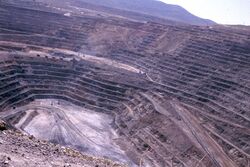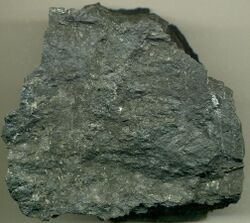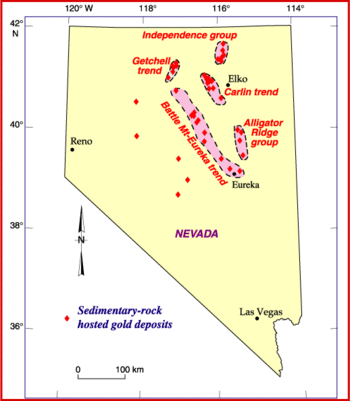Earth:Carlin–type gold deposit


Carlin–type gold deposits are sediment-hosted disseminated gold deposits. These deposits are characterized by invisible (typically microscopic and/or dissolved) gold in arsenic rich pyrite and arsenopyrite.[2] This dissolved kind of gold is called "Invisible Gold", as it can only be found through chemical analysis.[3] The deposit is named after the Carlin mine, the first large deposit of this type discovered in the Carlin Trend, Nevada.
Geology
The Carlin type deposits show enrichment in the elements gold, arsenic, antimony, mercury, thallium and barium. This enrichment is created by hydrothermal circulation with a temperature of up to 300 °C. The underlying rocks out of which the minerals are dissolved are normally silty carbonates, although silicates and other sediments are possible. The source of the heating for the water in the hydrothermal circulation is still under discussion.[4] The material in the deposit is altered in a way that the carbonate minerals are either dissolved or converted to the silicates by silicate rich hydrothermal water. For example, dolomite is transformed into jasperoid. Another alteration is the formation of clay minerals by interaction of water and feldspar. The absence of base metal sulfides and the even distribution of the pyrite and arsenopyrite in the host rock are the most obvious difference to other sulfide deposits.[5]
Mining
The Carlin–type deposits represent some of the largest hydrothermal gold deposits in the world.[6] The invisible nature of the gold in the deposit makes it difficult to find deposits of that kind. The class of deposit was defined after the Carlin mine became a mass producer of gold in the 1960s and it was recognized that other deposits of that type should exist.[5] Most of the mines in the Great Basin in the United States belong to the Carlin type. Similar "Invisible Gold" deposits have also been found in northern Canada,[7] China,[8] Iran,[9][10] and Macedonia;[11] but the relationship between these deposits and those in Nevada are debated.
See also
- Gold mining in Nevada
References
- ↑ Fluid evolution and age of Carlin-type gold deposits at USGS
- ↑ Reich, Martin; Kesler, Stephen E.; Utsunomiya, Satoshi; Palenik, Christopher S.; Chryssoulis, Stephen L.; Ewing, Rodney C. (June 2005). "Solubility of gold in arsenian pyrite" (in en). Geochimica et Cosmochimica Acta 69 (11): 2781–2796. doi:10.1016/j.gca.2005.01.011. Bibcode: 2005GeCoA..69.2781R. https://linkinghub.elsevier.com/retrieve/pii/S001670370500061X.
- ↑ Gopon, Phillip; Douglas, James O.; Auger, Maria A.; Hansen, Lars; Wade, Jon; Cline, Jean S.; Robb, Laurence J.; Moody, Michael P. (2019-09-01). "A Nanoscale Investigation of Carlin-Type Gold Deposits: An Atom-Scale Elemental and Isotopic Perspective" (in en). Economic Geology 114 (6): 1123–1133. doi:10.5382/econgeo.4676. ISSN 1554-0774. Bibcode: 2019EcGeo.114.1123G. https://pubs.geoscienceworld.org/segweb/economicgeology/article/114/6/1123/573422/A-Nanoscale-Investigation-of-CarlinType-Gold.
- ↑ Muntean, John L.; Cline, Jean S.; Simon, Adam C.; Longo, Anthony A. (February 2011). "Magmatic–hydrothermal origin of Nevada's Carlin-type gold deposits" (in en). Nature Geoscience 4 (2): 122–127. doi:10.1038/ngeo1064. ISSN 1752-0894. Bibcode: 2011NatGe...4..122M. http://www.nature.com/articles/ngeo1064.
- ↑ 5.0 5.1 Arehart, G. (1996). "Characteristics and origin of sediment-hosted disseminated gold deposits: a review". Ore Geology Reviews 11 (6): 383–403. doi:10.1016/S0169-1368(96)00010-8. Bibcode: 1996OGRv...11..383A. Archived from the original on 2010-12-14. https://web.archive.org/web/20101214112301/http://wolfweb.unr.edu/homepage/arehart/pubs/ArehartOGR1996.pdf.
- ↑ Kesler, Stephen E.; Riciputi, Lee C.; Ye, Zaojun (2005). "Evidence for a magmatic origin for Carlin-type gold deposits: isotopic composition of sulfur in the Betze–Post–Screamer Deposit, Nevada, USA". Mineralium Deposita 40 (2): 127–136. doi:10.1007/s00126-005-0477-9. Bibcode: 2005MinDe..40..127K. https://deepblue.lib.umich.edu/bitstream/2027.42/46046/1/126_2005_Article_477.pdf.
- ↑ Pinet, Nicolas; Mercier-Langevin; Dubé; Colpron; Lane; Asselin (2017). Lithotectonic controls on the genesis and distribution of carbonate replacement-type ('Carlin-type') gold zones, east-central Yukon. doi:10.13140/RG.2.2.12346.39369. http://rgdoi.net/10.13140/RG.2.2.12346.39369.
- ↑ Rui-Zhong, Hu; Wen-Chao, Su; Xian-Wu, Bi; Guang-Zhi, Tu; Hofstra, Albert (2002). "Geology and geochemistry of Carlin-type gold deposits in China". Mineralium Deposita 37 (3–4): 378–392. doi:10.1007/s00126-001-0242-7. Bibcode: 2002MinDe..37..378R.
- ↑ Asadi, H.H.; Voncken, J.H.L.; Hale, M (1999). "Invisible Gold at Zarshuran, Iran". Economic Geology 94 (8): 1367–1374. doi:10.2113/gsecongeo.94.8.1367. Bibcode: 1999EcGeo..94.1367A.
- ↑ Asadi, H.H.; Voncken, J.H.L.; Kühnel, R.A.; Hale, M. (2000). "Petrography, Mineralogy and Geochemistry of the Zarshuran Carlin-like Gold Deposit, northwest Iran". Mineralium Deposita 35 (7): 656–671. doi:10.1007/s001260050269. Bibcode: 2000MinDe..35..656A.
- ↑ Volkov, A. V.; Serafimovski, T.; Kochneva, N. T.; Tomson, I. N.; Tasev, G. (2006). "The Alshar epithermal Au-As-Sb-Tl deposit, southern Macedonia". Geology of Ore Deposits 48 (3): 175–192. doi:10.1134/S1075701506030020. Bibcode: 2006GeoOD..48..175V. http://eprints.ugd.edu.mk/1620/1/GRM%20Alshar%20Geology%20of%20Ore%20Deposits06.pdf.
External links
- "The Rush to Uncover Gold’s Origins", Geotimes, April 2006
 |


